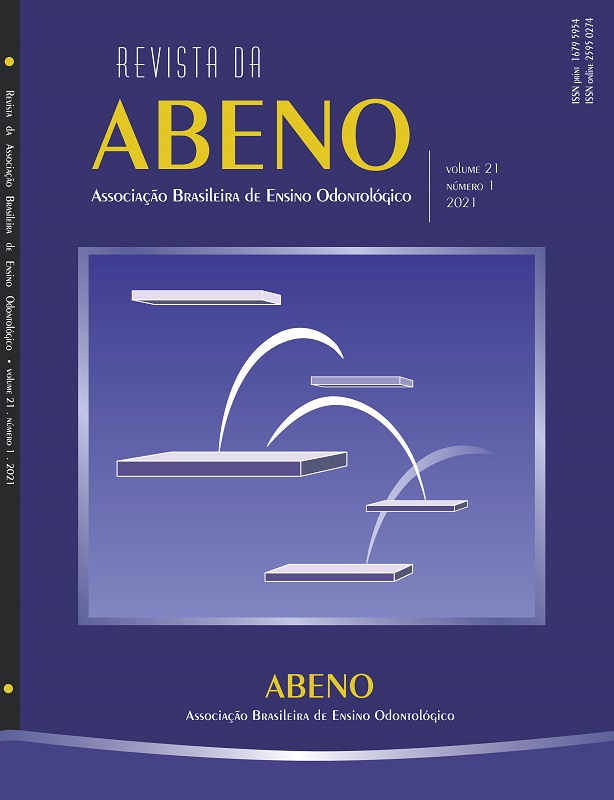Dental students' knowledge and attitudes toward patients with epilepsy
DOI:
https://doi.org/10.30979/rev.abeno.v21i1.1087Palabras clave:
Epilepsy. Knowledge. Social Stigma. Dental Students. Surveys and Questionnaires.Resumen
Epilepsy is defined as a group of symptoms resulting from several neuronal complications ranging from changes in consciousness and motor activity to sensory phenomena and aberrant behaviors. This health problem has been associated with cases of stigma that can seriously affect the patient's quality of life. This study's main objective was to investigate the knowledge and attitudes regarding the treatment of patients diagnosed with epilepsy by undergraduate dentistry students. The methodology was based on applying a structured questionnaire with 17 close-ended questions that evaluated information such as sociodemographic data, knowledge about epilepsy and social tolerance. The sample consisted of 397 students enrolled in the Dentistry course at Federal University of Paraná and divided into: group 1, students attending the 1st to the 7th semester of the course, and group 2, students in the last semester of the course. Group 1 students had more opportunities to care for patients with epilepsy than group 2. Most students expressed positive attitudes toward living with people suffering from epilepsy and considered that they could not exercise certain professional activities. The question with the least number of correct answers dealt with the treatment of patients with the disease. Students' knowledge of epilepsy was low. However, the level of positive attitudes toward living with this type of patient was considered high.
Descargas
Citas
(1) Chang BS, Lowenstein DH. Epilepsy. N Engl J Med. 2003;349(13):1257-66.
(2) Fisher R, van Emde Boas W, Blume W, Elger C, Genton P, Lee P, Engel J. Epileptic seizures and epilepsy: definitions proposed by the International League Against Epilepsy (ILAE) and the International Bureau for Epilepsy (IBE). Epilepsia. 2005; 46(4):470-2.
(3) Magiorkinis E, Sidiropoulou K, Diamantis A. Hallmarks in the history of epilepsy: epilepsy in antiquity. Epilepsy Behav. 2010;17(1):103-8.
(4) Eade R, Chapman SC, Horne R, Balestrini S, Rush J, Sisodiya SM. Applying a perceptions and practicalities approach to understanding nonadherence to antiepileptic drugs. Epilepsia. 2015;56(9):1398-407.
(5) Thurman DJ, Beghi E, Begley CE, Berg AT, Buchhalter JR, Ding D, et al. Standards for epidemiologic studies and surveillance of epilepsy. Epilepsia. 2011; 52(7): 2–26.
(6) Brodie MJ, Elder AT, Kwan, P. Epilepsy in later life. Lancet Neurology. 2009; 8(11):1019–30.
(7) Holmes TR, Browne, GL. Handbook of epilepsy. 4ª ed. Filadélfia: Lippincott Williams & Wilkins. 2008.
(8) Cascino GD. Epilepsy: contemporary perspectives on evaluation and treatment. Mayo Clinic Proceedings. 1994; 69:1199–211.
(9) Berg, AT. Risk of recurrence after a first unprovoked seizure. Epilepsia. 2008; 49(1):13–8.
(10) Wyllie E. Wyllie's treatment of epilepsy: principles and practice. 5ª ed. Filadélfia: Wolters Kluwer/Lippincott Williams & Wilkins. 2010.
(11) Devlin AL, Odell M, Charlton J, Koppel S. Epilepsy and driving: current status of research. Epilepsy Research. 2012; 102(3):135–52.
(12) Newton, CR. Epilepsy in poor regions of the world. Lancet. 2012; 380(9848): 1193–201.
(13) Wilden JA, Cohen-Gadol AA. Evaluation of first nonfebrile seizures. American family physician. 2012; 86(4):334-40.
(14) Beghi E. The Epidemiology of epilepsy. Neuroepidemiology. 2020; 54(2):185-91.
(15) Falci SGM, Armond ACV. The Effectiveness of the Cold Therapy (cryotherapy) in the Management of Inflammatory Parameters after Removal of Mandibular Third Molars: A Meta-Analysis. Int Arch Otorhinolaryngol. 2019; 23(2):221-8.
(16) Hassona YM, Mahmoud AA, Ryalat SM, Sawair FA. Dental students knowledge and attitudes toward patients with epilepsy. Epilepsy & Behavior. 2014;36:2-5.
(17) Aragon CE, Hess T, Burneo JG. Knowledge and attitudes about epilepsy: a survey of dentists in London, Ontario. J Can Dent Assoc. 2009; 75:450.
(18) Doshi D, Reddy BS, Kulkarni S, Karunakar PNA. Dentists knowledge, attitudes and practices toward patients with epilepsy in Hyderabad city, India. Epilepsy Behav. 2012; 23:447-450.
(19) Sharma PK, Misra AK, Chugh A, Chugh VK, Gonnade N, Singh S. Gingival hyperplasia: Should drug interaction be blamed for? Indian J Pharmacol. 2017; 49(3):257-259.
(20) Kartal A. Knowledge Of, Perceptions Of, Attitudes and Practices Regarding Epilepsy Among Medical Students in Turkey. Epilepsy Behav. 2016; 58:115-8.
Descargas
Publicado
Cómo citar
Número
Sección
Licencia
Derechos de autor 2021 Revista da ABENO

Esta obra está bajo una licencia internacional Creative Commons Atribución-NoComercial 4.0.
Autores que publicam nesta revista concordam com os seguintes termos:
a) Autores mantém os direitos autorais e concedem à revista o direito de primeira publicação, com o trabalho simultaneamente licenciado sob a Licença Creative Commons Attribution que permite o compartilhamento do trabalho com reconhecimento da autoria e publicação inicial nesta revista.
b) Autores têm autorização para assumir contratos adicionais separadamente, para distribuição não-exclusiva da versão do trabalho publicada nesta revista (ex.: publicar em repositório institucional ou como capítulo de livro), com reconhecimento de autoria e publicação inicial nesta revista.
c) Autores têm permissão e são estimulados a publicar e distribuir seu trabalho online (ex.: em repositórios institucionais ou na sua página pessoal) a qualquer ponto antes ou durante o processo editorial, já que isso pode gerar alterações produtivas, bem como aumentar o impacto e a citação do trabalho publicado (Veja O Efeito do Acesso Livre).






